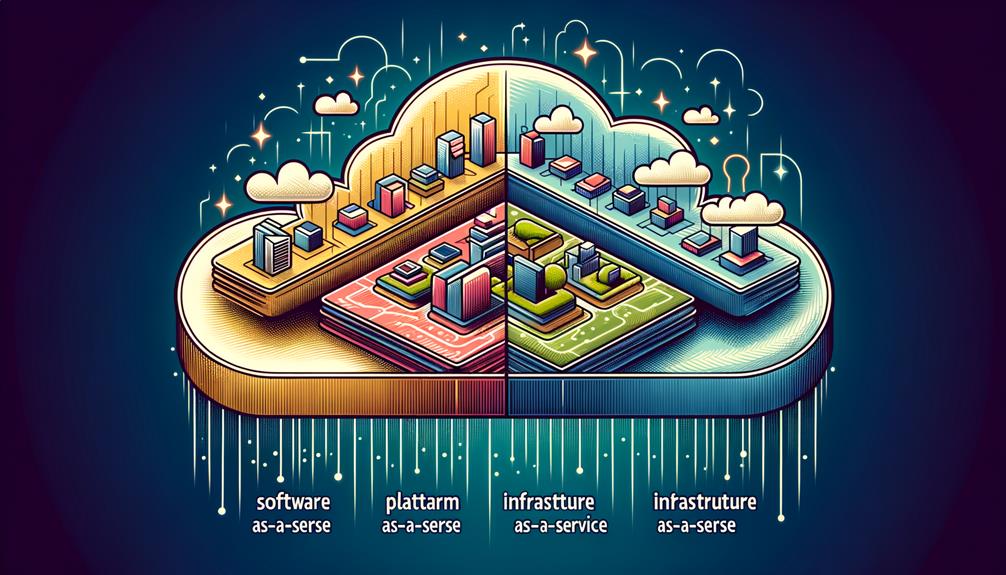As we embark on our journey into the vast world of cloud computing models, we find ourselves standing at the crossroads of SaaS, PaaS, and IaaS.
These three options, like the branches of a tree, offer distinct paths that can lead us to the cloud-based solutions we seek. But which path should we choose? Which model will provide us with the flexibility, scalability, and efficiency we crave?
In this discussion, we will unravel the mysteries behind SaaS, PaaS, and IaaS, shedding light on their unique characteristics and advantages.
So buckle up, my friends, as we set off on this cloud-filled adventure, where the sky's the limit and the possibilities are endless.
Saas: Accessing Software Through Providers
When it comes to accessing software through providers, SaaS (Software as a Service) offers businesses a convenient and efficient solution. Imagine a world where you no longer have to worry about installing and maintaining software on your own servers. With SaaS, you can simply access the software you need through third-party providers over the internet.
Gone are the days of spending hours troubleshooting technical issues or dealing with costly upgrades. SaaS liberates you from the burdens of traditional software management, allowing you to focus on what truly matters – growing your business.
Whether you need a CRM system like Salesforce or a project management tool like Asana, SaaS platforms like these offer flexibility, scalability, and seamless integration. Say goodbye to the shackles of outdated software and embrace the liberation that SaaS brings.
PaaS: Tools for Software Development
PaaS, the platform that empowers software developers with a range of powerful tools and resources, revolutionizes the way applications are built and deployed. With PaaS, developers can harness the full potential of the cloud to create innovative software solutions that liberate businesses from the constraints of traditional development methods.
Imagine having a suite of tools at your fingertips, ready to streamline your development process and unleash your creativity. PaaS offers just that. From development frameworks to database management systems, PaaS provides everything developers need to bring their ideas to life.
Take a look at the table below to see just a glimpse of the tools available on a PaaS platform:
| Tool | Description | Benefits |
|---|---|---|
| Development | Integrated development environments (IDEs) | Faster coding, collaboration, and debugging |
| Deployment | Continuous integration and deployment (CI/CD) | Automated testing and seamless deployment |
| Scalability | Elastic scaling capabilities | Easily handle traffic spikes and growth |
These are just a few examples of the powerful tools PaaS offers. With PaaS, developers can focus on what they do best: creating exceptional software. Say goodbye to the limitations of traditional development and embrace the freedom that PaaS brings.
IaaS: Flexible Cloud-based Infrastructure
With its flexible and scalable cloud-based infrastructure, IaaS revolutionizes the way businesses manage their resources and adapt to changing demands. Imagine having the power to instantly scale your infrastructure up or down based on your needs, without the hassle of investing in physical hardware or managing complex systems. This liberation is exactly what IaaS offers.
Here are three key benefits of IaaS:
- Freedom to focus on core business: With IaaS, businesses can offload the responsibility of managing infrastructure to the cloud service provider, allowing them to focus on their core competencies and strategic initiatives.
- Cost-effectiveness: Instead of investing in expensive hardware and maintaining it, IaaS allows businesses to pay only for the resources they use, reducing upfront costs and providing greater financial flexibility.
- Scalability and agility: IaaS enables businesses to quickly scale their infrastructure up or down as needed, providing the agility to respond to changing market conditions and customer demands.
With IaaS, businesses can break free from the limitations of traditional infrastructure and embrace a more flexible and dynamic approach to managing their resources.
Differentiating SaaS, PaaS, and IaaS
As we explore the differences between SaaS, PaaS, and IaaS, we uncover the unique characteristics and advantages that make each cloud computing model distinct.
SaaS, or Software as a Service, allows businesses to access software through third-party providers over the internet. It offers flexibility and scalability, eliminating the need for installation or maintenance.
PaaS, or Platform as a Service, provides hardware and software tools accessible online, allowing developers to focus on creating software without worrying about infrastructure. PaaS platforms are built on virtualization technology, offering scalability and ease of use for software development.
Finally, IaaS, or Infrastructure as a Service, works with cloud-based and pay-as-you-go services, providing flexibility and scalability for businesses' infrastructure needs. With IaaS, businesses can purchase resources on-demand instead of investing in physical hardware, putting control back in their hands.
Each model offers different features and advantages, allowing businesses to choose the one that best suits their needs.
Making the Right Decision for Your Business
When deciding on the best cloud computing model for your business, it's crucial to carefully consider the unique needs and requirements of your organization. Making the right decision can have a significant impact on your business's efficiency, scalability, and cost-effectiveness. Here are three key factors to consider:
- Scalability: Does your business require the ability to easily scale up or down its resources based on demand? If so, IaaS or PaaS models may be more suitable, as they offer flexible and on-demand resource allocation.
- Development Needs: Is your organization heavily reliant on software development? If yes, PaaS can provide developers with a platform to build and deploy applications efficiently.
- Cost Considerations: Evaluate your budget and determine which model aligns with your financial goals. SaaS may be a cost-effective option as it eliminates the need for hardware and software maintenance.
Frequently Asked Questions
What Are the Potential Risks and Challenges Associated With Adopting Saas, Paas, or Iaas?
When considering the potential risks and challenges associated with adopting SaaS, PaaS, or IaaS, it's important to assess the specific needs and goals of your business. Some common concerns include:
- Data security
- Vendor lock-in
- Integration issues
Additionally, there may be challenges related to:
- Customization
- Scalability
- Reliance on third-party providers
It's crucial to thoroughly evaluate the capabilities and limitations of each cloud computing model to make an informed decision that aligns with your business objectives.
How Do Saas, Paas, and Iaas Affect Data Security and Privacy?
When it comes to data security and privacy, SaaS, PaaS, and IaaS all have different implications.
SaaS, being fully managed by third-party providers, means that the responsibility for security lies with them.
PaaS gives developers more control over security measures, as they're building their own software.
IaaS allows businesses to have control over the security of their infrastructure.
It's important to carefully consider the specific needs and priorities of your business when choosing between these cloud computing models to ensure the highest level of data security and privacy.
Can Businesses Use a Combination of Saas, Paas, and Iaas Simultaneously?
Yes, businesses can absolutely use a combination of SaaS, PaaS, and IaaS simultaneously.
By leveraging the strengths of each model, businesses can create a comprehensive and efficient cloud computing strategy.
SaaS allows for easy access to ready-to-use software.
PaaS provides developers with the tools and platform to build their own applications.
IaaS offers the flexibility and scalability of cloud-based infrastructure.
This combination empowers businesses to tailor their cloud solutions to their specific needs and optimize their operations.
Are There Any Limitations or Restrictions on the Customization and Flexibility of Saas, Paas, and Iaas Platforms?
There are indeed limitations and restrictions on the customization and flexibility of SaaS, PaaS, and IaaS platforms. While SaaS offers ready-to-use solutions, customization options may be limited since the software is fully managed by another company.
PaaS provides more flexibility for app development, but there may still be restrictions depending on the platform. Developers can customize the applications and choose the programming languages and tools, but they may have to work within the constraints of the PaaS provider's environment.
IaaS grants more control over infrastructure, as businesses have direct access to virtual machines, storage, and networking components. However, customization may still be limited by the underlying cloud service provider's infrastructure. Businesses may not have complete control over the hardware and network configurations.
It's important to carefully consider these factors when choosing the right cloud computing model for your business. Each model has its own trade-offs between convenience and flexibility, and understanding these limitations will help you make an informed decision.
How Do the Costs of Implementing and Maintaining Saas, Paas, and Iaas Compare to Traditional On-Premise Solutions?
Implementing and maintaining SaaS, PaaS, and IaaS can offer significant cost savings compared to traditional on-premise solutions.
With SaaS, businesses eliminate the need for expensive software installations and updates.
PaaS allows developers to focus on building software without the upfront costs of infrastructure.
IaaS provides businesses with the flexibility to scale their infrastructure as needed, avoiding the expenses of purchasing and maintaining physical hardware.
Conclusion
In conclusion, understanding the differences between SaaS, PaaS, and IaaS is crucial for businesses looking to embrace the benefits of cloud computing.
Each model offers unique advantages, whether it's the flexibility and scalability of SaaS, the tools for software development provided by PaaS, or the infrastructure flexibility of IaaS.
By making an informed decision, businesses can unlock the full potential of the cloud and propel their success in today's digital landscape.
So, embrace the possibilities and choose the cloud computing model that best suits your specific needs.



